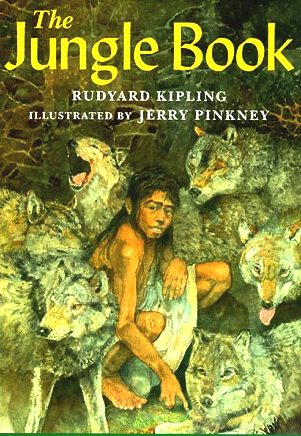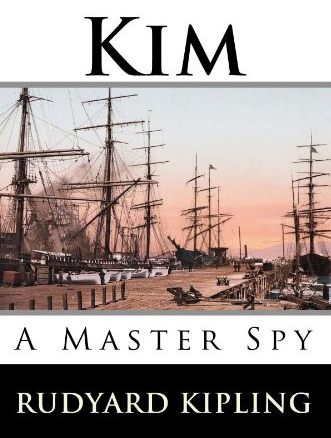|
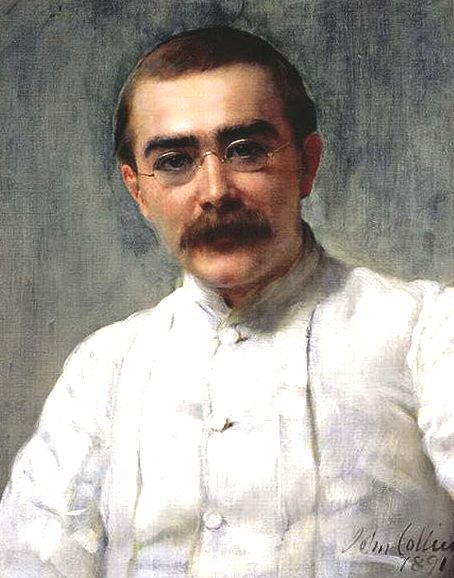
Joseph Rudyard Kipling
(30 December 1865 – 18 January 1936) was an English short-story writer, poet, and novelist chiefly remembered for his tales and poems of British soldiers in India and his tales for children. He was born in Bombay, in the Bombay Presidency of British India, and was taken by his family to England when he was five years old. Kipling is best known for his works of fiction, including The
Jungle Book (a collection of stories which includes "Rikki-Tikki-Tavi"), Just So Stories (1902), Kim (1901) (a tale of adventure), many short stories, including "The Man Who Would Be King" (1888); and his poems, including "Mandalay" (1890), "Gunga Din" (1890), "The White Man's Burden" (1899) and "If—" (1910). He is regarded as a major "innovator in the art of the short story"; his children's books are enduring classics of children's literature; and his best works are said to exhibit "a versatile and luminous narrative gift".
Kipling was one of the most popular writers in England, in both prose and verse, in the late 19th and early 20th centuries. Henry James said: "Kipling strikes me personally as the most complete man of genius (as distinct from fine intelligence) that I have ever known." In 1907 he was awarded the
Nobel Prize in Literature, making him the first
English-language writer to receive the prize, and to date he remains its youngest
recipient. Among other honours, he was sounded out for the British Poet Laureateship and on several occasions for a knighthood, all of which he declined.
Kipling's subsequent reputation has changed according to the political and social climate of the age and the resulting contrasting views about him continued for much of the 20th century. George Orwell called him a "prophet of British imperialism". Literary critic Douglas Kerr wrote: "He [Kipling] is still an author who can inspire passionate disagreement and his place in literary and cultural history is far from settled. But as the age of the European empires recedes, he is recognised as an incomparable, if controversial, interpreter of how empire was experienced. That, and an increasing recognition of his extraordinary narrative gifts, make him a force to be reckoned with."
S USSEX
In 1897, Kipling moved from Torquay to Rottingdean, East Sussex; first to North End House and later to The Elms. In 1902 Kipling bought
Bateman's, a house built in 1634 and located in rural Burwash, East
Sussex, England. Bateman's was Kipling's home from 1902 until his death in 1936. The house, along with the surrounding buildings, the mill and 33 acres (130,000 m2) was purchased for
£9,300. It had no bathroom, no running water upstairs and no electricity, but Kipling loved it: "Behold us, lawful owners of a grey stone lichened house
- A.D. 1634 over the door—beamed, panelled, with old oak staircase, and all untouched and unfaked. It is a good and peaceable place. We have loved it ever since our first sight of it." (from a November 1902 letter).
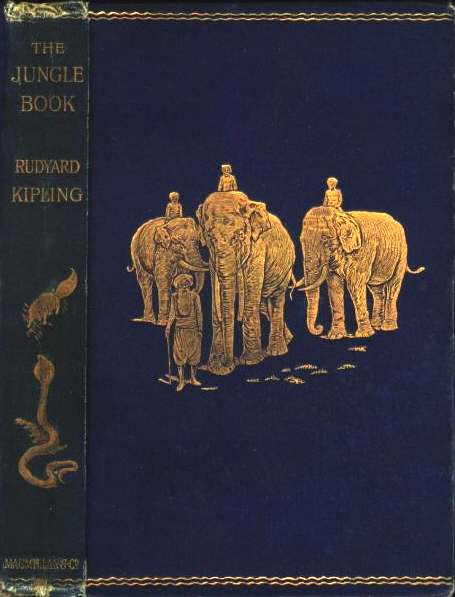
CHILDHOOD
Rudyard Kipling was born on 30 December 1865 in Bombay, in the Bombay Presidency of British India, to Alice Kipling (née
MacDonald) and (John) Lockwood Kipling. Alice (one of four remarkable Victorian sisters) was a vivacious woman about whom a
future Viceroy of India would say, "Dullness and Mrs. Kipling cannot exist in the same room." Lockwood Kipling, a sculptor and
pottery designer, was the Principal and Professor of Architectural
Sculpture at the newly founded Sir Jamsetjee Jeejebhoy School of Art in Bombay.
John Lockwood and Alice had met in 1863 and courted at Rudyard Lake in Rudyard, Staffordshire, England. They married, and moved to
India in 1865. They had been so moved by the beauty of the Rudyard Lake area that when their first child was born, they included a
reference to the lake in naming him. Alice's sister Georgiana was married to painter Edward Burne-Jones, and her sister Agnes was
married to painter Edward Poynter. Kipling's most famous relative was his first cousin, Stanley Baldwin, who was
Conservative Prime
Minister of the UK three times in the 1920s and 1930s.
Kipling's birth home still stands on the campus of the J J School of Art in Mumbai and for many years was used as the Dean's
residence. Bombay historian Foy Nissen points out, however, that although the cottage bears a plaque stating that this is the site
where Kipling was born, the original cottage was torn down decades ago and a new one was built in its place. The wooden bungalow has
been empty and locked up for years.
According to Bernice M. Murphy, "Kipling’s parents considered
themselves 'Anglo-Indians' (a term used in the 19th century for people of British origin living in India) and so too would their
son, though he spent the bulk of his life elsewhere. Complex issues of identity and national allegiance would become prominent features
in his fiction." Kipling referred to such conflicts; for example: "In the afternoon heats before we took our sleep, she (the
Portuguese ayah, or nanny) or Meeta (the Hindu bearer, or male attendant) would tell us stories and Indian nursery songs all
unforgotten, and we were sent into the dining-room after we had been dressed, with the caution 'Speak English now to Papa and
Mamma.' So one spoke 'English', haltingly translated out of the vernacular idiom that one thought and dreamed in".
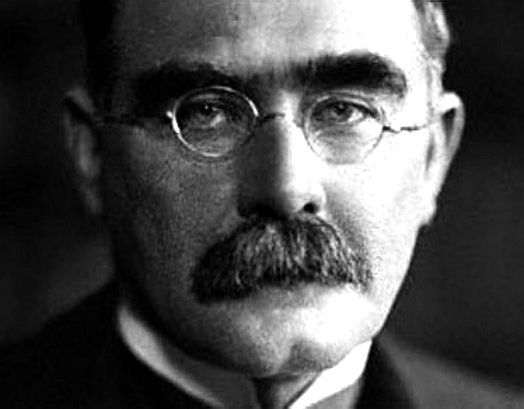
Kipling's days of "strong light and darkness" in Bombay ended when he was five years old. As was the custom in British India, he and
his three-year-old sister Alice ("Trix") were taken to England - in their case to Southsea,
Portsmouth - to live with a couple who boarded children of British nationals who were serving in India.
For the next six years, from October 1871 to April 1877, the two children lived with the couple, Captain Pryse Agar Holloway, once
an officer in the merchant navy, and Mrs Sarah Holloway, at their house, Lorne Lodge at 4 Campbell Road, Southsea. In his
autobiography, published some 65 years later, Kipling recalled the stay with horror, and wondered ironically if the combination of
cruelty and neglect which he experienced there at the hands of Mrs. Holloway might not have hastened the onset of his literary life:
"If you cross-examine a child of seven or eight on his day’s doings (specially when he wants to go to sleep) he will contradict himself
very satisfactorily. If each contradiction be set down as a lie and retailed at breakfast, life is not easy. I have known a certain
amount of bullying, but this was calculated torture—religious as well as scientific. Yet it made me give attention to the lies I
soon found it necessary to tell: and this, I presume, is the foundation of literary effort".
Trix fared better at Lorne Lodge; Mrs. Holloway apparently hoped that Trix would eventually marry the Holloway son. The two Kipling
children, however, did have relatives in England whom they could visit. They spent a month each
Christmas with their maternal aunt Georgiana ("Georgy") and her husband at their house, "The Grange,"
in Fulham, London, which Kipling was to call "a paradise which I verily believe saved me." In the spring of 1877, Alice returned
from India and removed the children from Lorne Lodge. Kipling remembers, "Often and often afterwards, the beloved Aunt would ask
me why I had never told any one how I was being treated. Children tell little more than animals, for what comes to them they accept
as eternally established. Also, badly-treated children have a clear notion of what they are likely to get if they betray the secrets of
a prison-house before they are clear of it".
In January 1878, Kipling was admitted to the United Services College at Westward Ho!, Devon, a school founded a few years
earlier to prepare boys for the British Army. The school proved rough going for him at first, but later led to firm friendships,
and provided the setting for his schoolboy stories Stalky & Co. (1899). During his time there, Kipling also met and fell in love
with Florence Garrard, who was boarding with Trix at Southsea (to which Trix had returned). Florence was to become the model for
Maisie in Kipling's first novel, The Light that Failed (1891).
Near the end of his stay at the school, it was decided that he lacked the academic ability to get into Oxford University on a
scholarship and his parents lacked the wherewithal to finance him, so Lockwood obtained a job for his son in Lahore, Punjab (now in
Pakistan), where Lockwood was Principal of the Mayo College of Art
and Curator of the Lahore Museum. Kipling was to be assistant editor of a small local newspaper, the Civil & Military Gazette.
He sailed for India on 20 September 1882 and arrived in Bombay on 18 October. He described this moment years later: "So, at sixteen
years and nine months, but looking four or five years older, and adorned with real whiskers which the scandalised Mother abolished
within one hour of beholding, I found myself at Bombay where I was born, moving among sights and smells that made me deliver in the
vernacular sentences whose meaning I knew not. Other Indian-born boys have told me how the same thing happened to them." This
arrival changed Kipling, as he explains: "There were yet three or four days’ rail to Lahore, where my people lived. After these, my
English years fell away, nor ever, I think, came back in full strength".
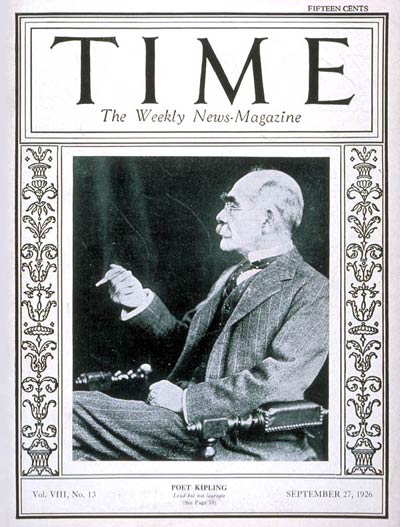
WRITING CAREER
In London, Kipling had several stories accepted by various magazine editors. He also found a place to live for the next two years:The experience in his own words: "Meantime, I had found me quarters
in Villiers Street, Strand, which forty-six years ago was primitive and passionate in its habits and population. My rooms were small,
not over-clean or well-kept, but from my desk I could look out of my window through the fanlight of Gatti’s Music-Hall entrance,
across the street, almost on to its stage. The Charing Cross trains rumbled through my dreams on one side, the boom of the Strand on
the other, while, before my windows, Father Thames under the Shot Tower walked up and down with his traffic".
In the next two years, he published a novel, The Light that Failed, had a nervous breakdown, and met an American writer and publishing
agent, Wolcott Balestier, with whom he collaborated on a novel, The Naulahka (a title which he uncharacteristically misspelt; see
below). In 1891, on the advice of his doctors, Kipling embarked on another sea voyage visiting South Africa,
Australia, New Zealand, and once again India. However, he cut short his plans for spending
Christmas with his family in India when he heard of Balestier's sudden death from typhoid fever, and immediately decided to return
to London. Before his return, he had used the telegram to propose to and be accepted by Wolcott's sister Caroline Starr Balestier
(1862–1939), called "Carrie", whom he had met a year earlier, and with whom he had apparently been having an intermittent
romance. Meanwhile, late in 1891, his collection of short stories of the British in India, Life's Handicap, was published in
London.
On 18 January 1892, Carrie Balestier (aged 29) and Rudyard Kipling (aged 26) were married in London, in the "thick of an influenza
epidemic, when the undertakers had run out of black horses and the dead had to be content with brown ones." The wedding was held at
All Souls Church, Langham Place. Henry James gave the bride away.
UNITED STATES
The couple settled upon a honeymoon that would take them first to the United States (including a stop at the Balestier family estate
near Brattleboro, Vermont) and then on to Japan. However, when they
arrived in Yokohama, Japan, they discovered that their bank, The New Oriental Banking Corporation, had failed. Taking this loss in
their stride, they returned to the U.S., back to Vermont—Carrie by this time was pregnant with their first child—and rented a small
cottage on a farm near Brattleboro for ten dollars a month. According to Kipling, "We furnished it with a simplicity that
fore-ran the hire-purchase system. We bought, second or third hand, a huge, hot-air stove which we installed in the cellar. We cut
generous holes in our thin floors for its eight-inch [20 cm] tin pipes (why we were not burned in our beds each week of the winter I
never can understand) and we were extraordinarily and self-centredly content."
In this house, which they called Bliss Cottage, their first child, Josephine, was born "in three foot of snow on the night of 29
December 1892. Her Mother’s birthday being the 31st and mine the 30th of the same month, we congratulated her on her sense of the
fitness of things ..."
It was also in this cottage that the first dawnings of the Jungle Books came to Kipling: " . . workroom in the Bliss Cottage was
seven feet by eight, and from December to April the snow lay level with its window-sill. It chanced that I had written a tale about
Indian Forestry work which included a boy who had been brought up by wolves. In the stillness, and suspense, of the winter of ’92
some memory of the Masonic Lions of my childhood’s magazine, and a phrase in Haggard’s Nada the Lily, combined with the echo of this
tale. After blocking out the main idea in my head, the pen took charge, and I watched it begin to write stories about Mowgli and
animals, which later grew into the two Jungle Books ". With Josephine's arrival, Bliss Cottage was felt to be congested, so
eventually the couple bought land—10 acres (40,000 m2) on a rocky hillside overlooking the Connecticut River—from Carrie's brother
Beatty Balestier, and built their own house.
Kipling named the house Naulakha, in honour of Wolcott and of their collaboration, and this time the name was spelled correctly. From
his early years in Lahore (1882–87), Kipling had become enamored with the Mughal architecture, especially the Naulakha pavilion
situated in Lahore Fort, which eventually became an inspiration for the title of his novel as well as the house.
The house still stands on Kipling Road, three miles (5 km) north of Brattleboro in Dummerston, Vermont: a big, secluded, dark-green
house, with shingled roof and sides, which Kipling called his
"ship", and which brought him "sunshine and a mind at
ease." His seclusion in Vermont, combined with his healthy "sane clean life",
made Kipling both inventive and prolific.
In the short span of four years, he produced, in addition to the Jungle Books, a collection of short stories (The Day's Work), a
novel (Captains Courageous), and a profusion of poetry, including the volume The Seven Seas. The collection of Barrack-Room Ballads
was issued in March 1892, first published individually for the most part in 1890, and containing his poems "Mandalay" and "Gunga Din".
He especially enjoyed writing the Jungle Books—both masterpieces of imaginative writing—and enjoyed, too, corresponding with the many
children who wrote to him about them.
The writing life in naulakha was occasionally interrupted by visitors, including his father, who visited soon after his
retirement in 1893, and British writer Arthur Conan
Doyle, who brought his golf-clubs, stayed for two days, and gave Kipling an
extended golf lesson. Kipling seemed to take to golf, occasionally practising with the local Congregational minister, and even playing
with red-painted balls when the ground was covered in snow. However, wintertime golf was "not altogether a success because
there were no limits to a drive; the ball might skid two miles (3 km) down the long slope to Connecticut river."
From all accounts, Kipling loved the outdoors, not least of whose marvels in Vermont was the turning of the leaves each fall. He
described this moment in a letter: "A little maple began it, flaming blood-red of a sudden where he stood against the dark green
of a pine-belt. Next morning there was an answering signal from the swamp where the sumacs grow. Three days later, the hill-sides as
fast as the eye could range were afire, and the roads paved, with crimson and gold. Then a wet
wind blew, and ruined all the uniforms
of that gorgeous army; and the oaks, who had held themselves in reserve, buckled on their dull and bronzed cuirasses and stood it
out stiffly to the last blown leaf, till nothing remained but pencil-shadings of bare boughs, and one could see into the most
private heart of the woods."
In February 1896, Elsie Kipling was born, the couple's second daughter. By this time, according to several biographers, their
marital relationship was no longer light-hearted and spontaneous. Although they would always remain loyal to each other, they seemed
now to have fallen into set roles. In a letter to a friend who had become engaged around this time, the 30 year old Kipling offered
this sombre counsel: marriage principally taught "the tougher
virtues—such as humility, restraint, order, and forethought."
The Kiplings loved life in Vermont and might have lived out their lives there, were it not for two incidents—one of global politics,
the other of family discord—that hastily ended their time there. By the early 1890s, the United Kingdom and Venezuela were in a border
dispute involving British Guiana. The U.S. had made several offers to arbitrate, but in 1895 the new American Secretary of State
Richard Olney upped the ante by arguing for the American "right" to arbitrate on grounds of sovereignty on the continent (see the Olney
interpretation as an extension of the Monroe Doctrine). This raised hackles in the UK, and the situation grew into a major
Anglo-American crisis, with talk of war on both sides.
Although the crisis led to greater US-British cooperation, at the time Kipling was bewildered by what he felt was persistent
anti-British sentiment in the U.S., especially in the press. He wrote in a letter that it felt like being "aimed at with a decanter
across a friendly dinner table." By January 1896, he had decided to end his family's "good wholesome life" in the U.S. and seek their
fortunes elsewhere.
A family dispute became the final straw. For some time, relations between Carrie and her brother Beatty Balestier had been strained,
owing to his drinking and insolvency. In May 1896, an inebriated
Beatty encountered Kipling on the street and threatened him with physical harm. The incident led to Beatty's eventual arrest, but in
the subsequent hearing, and the resulting publicity, Kipling's privacy was destroyed, and he was left feeling miserable and
exhausted. In July 1896, a week before the hearing was to resume, the Kiplings packed their belongings, left the
United States, and
returned to England.
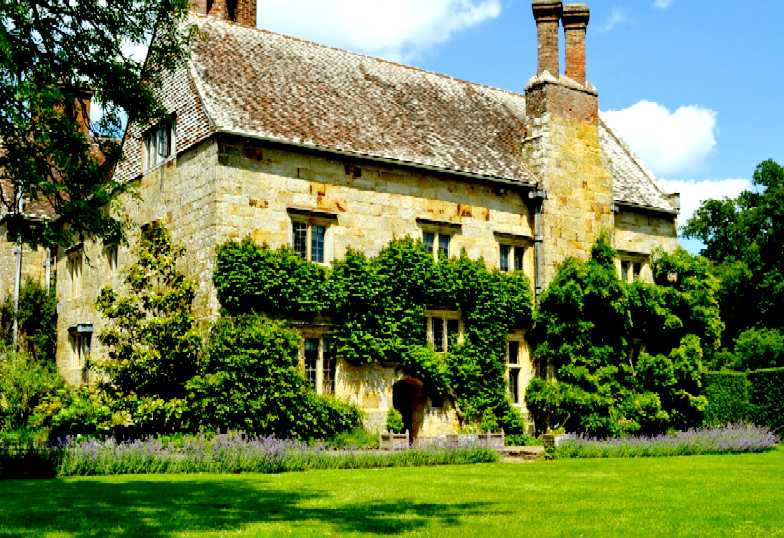
DEVON
By September 1896, the Kiplings were in Torquay, Devon, on the southwestern coast of England, in a hillside home overlooking the
English Channel. Although Kipling did not much care for his new house, whose design, he claimed, left its occupants feeling
dispirited and gloomy, he managed to remain productive and socially active. Kipling was now a famous man, and in the previous two
or three years, had increasingly been making political pronouncements in his writings. The Kiplings had welcomed their
first son, John, in August 1897. Kipling had begun work on two poems, "Recessional" (1897) and "The White Man's Burden" (1899)
which were to create controversy when published. Regarded by some as anthems for enlightened and duty-bound empire-building (that
captured the mood of the Victorian age), the poems equally were regarded by others as propaganda for brazenfaced imperialism and
its attendant racial attitudes; still others saw irony in the poems and warnings of the perils of empire.
A prolific writer during his time in Torquay, he also wrote Stalky & Co., a collection of school stories (born of his experience at
the United Services College in Westward Ho!) whose juvenile protagonists displayed a know-it-all, cynical outlook on patriotism
and authority. According to his family, Kipling enjoyed reading aloud stories from Stalky & Co. to them, and often went into spasms
of laughter over his own jokes.
SOUTH AFRICA
In early 1898 the Kiplings travelled to South Africa for their winter holiday, thus beginning an annual tradition which (excepting the following year) was to last until 1908. They always stayed in "The Woolsack", a house on Cecil Rhodes' estate at Groote Schuur (and now a student residence for the University of Cape Town); it was within walking distance of Rhodes' mansion. With his new reputation as Poet of the Empire, Kipling was warmly received by some of the most influential politicians of the Cape Colony, including Rhodes, Sir Alfred Milner, and Leander Starr Jameson. Kipling cultivated their friendship and came to admire the men and their politics. The period 1898–1910 was crucial in the history of South Africa and included the Second Boer War (1899–1902), the ensuing peace treaty, and the 1910 formation of the Union of South Africa. Back in England, Kipling wrote poetry in support of the British cause in the Boer War and on his next visit to
South Africa in early 1900, he became a correspondent for The Friend newspaper in Bloemfontein, which had been commandeered by Lord Roberts for British troops. Although his journalistic stint was to last only two weeks, it was Kipling's first work on a newspaper staff since he left The Pioneer in Allahabad more than ten years earlier. At The Friend he made lifelong friendships with Perceval Landon, H. A. Gwynne and others. He also wrote articles published more widely expressing his views on the conflict. Kipling penned an inscription for the Honoured Dead Memorial (Siege memorial) in Kimberley.

SUSSEX
In 1897, Kipling moved from Torquay to Rottingdean, East Sussex; first to North End House and later to The Elms. In 1902 Kipling bought Bateman's, a house built in 1634 and located in rural Burwash, East Sussex, England. Bateman's was Kipling's home from 1902 until his death in 1936. The house, along with the surrounding buildings, the mill and 33 acres (130,000 m2) was purchased for £9,300. It had no bathroom, no running water upstairs and no electricity, but Kipling loved it: "Behold us, lawful owners of a grey stone lichened house—A.D. 1634 over the door—beamed, panelled, with old oak staircase, and all untouched and unfaked. It is a good and peaceable place. We have loved it ever since our first sight of it." (from a November 1902 letter).
POLITICS
In the non-fiction realm he also became involved in the debate over the British response to the rise in German naval power known as the
Tirpitz Plan to build a fleet to challenge the
Royal Navy, publishing a series of articles in 1898 which were collected as A Fleet in Being. On a visit to the United States in 1899, Kipling and Josephine developed pneumonia, from which she eventually died. Kipling began collecting material for another of his children's classics, Just So Stories for Little Children. That work was published in 1902, the year after Kim was first issued. The first decade of the 20th century saw Kipling at the height of his popularity. In 1906 he wrote the song "Land of our Birth, We Pledge to Thee". Kipling wrote two science fiction short stories, With the Night Mail (1905) and As Easy As A. B. C (1912), both set in the 21st century in Kipling's Aerial Board of Control universe. These read like modern hard science fiction, and introduced the literary technique known as indirect exposition, which would later become one of Heinlein's
trademarks.
In 1907 he was awarded the Nobel Prize for Literature. The prize citation said: "In consideration of the power of observation, originality of imagination, virility of ideas and remarkable talent for narration which characterize the creations of this world-famous author." Nobel prizes had been established in 1901 and Kipling was the first English-language recipient. At the award ceremony in Stockholm on 10 December 1907, the Permanent Secretary of the Swedish Academy, Carl David af Wirsén, praised both Kipling and three centuries of English literature:
The Swedish Academy, in awarding the Nobel Prize in Literature this year to Rudyard Kipling, desires to pay a tribute of homage to the literature of England, so rich in manifold glories, and to the greatest genius in the realm of narrative that that country has produced in our times.
"Book-ending" this achievement was the publication of two connected poetry and story collections: Puck of Pook's Hill (1906), and Rewards and Fairies (1910). The latter contained the poem "If—". In a 1995 BBC opinion poll, it was voted the UK's favourite poem. This exhortation to self-control and stoicism is arguably Kipling's most famous poem.
Many older editions of Rudyard Kipling's books have a swastika printed on their covers associated with a picture of an elephant carrying a lotus flower, reflecting the influence of Indian culture. Kipling's use of the swastika was based on the Indian sun symbol conferring good luck and the Sanskrit word meaning "fortunate" or "well-being". In a note to Edward Bok written after the death of Lockwood Kipling in 1911, Rudyard said: "I am sending with this for your acceptance, as some little memory of my father to whom you were so kind, the original of one of the plaques that he used to make for me. I thought it being the
Swastika would be appropriate for your Swastika. May it bring you even more good fortune." He used the swastika symbol in both
right and left-facing orientations, and it was in general use at the time.
Such was Kipling's popularity that he was asked by his friend Max Aitken to intervene in the 1911 Canadian election on behalf of the Conservatives. On 7 September 1911, the Montreal Daily Star newspaper published a front-page appeal to all Canadians against the reciprocity agreement with the United States by Kipling who wrote: "It is her own soul that
Canada risks today. Once that soul is pawned for any consideration, Canada must inevitably conform to the commercial, legal, financial, social and ethical standards which will be imposed on her by the sheer admitted weight of the United States." Over the next week, Kipling's appeal was reprinted in every English newspaper in Canada, and is credited with helping to turn Canadian public opinion against the Liberal government that signed the reciprocity agreement. Kipling sympathised with the anti-Home Rule stance of Irish Unionists. He was friends with Edward Carson, the Dublin-born leader of Ulster Unionism, who raised the Ulster Volunteers to oppose "Home Rule" in Ireland. Kipling wrote the poem "Ulster" in 1912 reflecting this. Kipling was a staunch opponent of Bolshevism, a position which he shared with his friend Henry Rider Haggard. The two had bonded upon Kipling's arrival in London in 1889 largely on the strength of their shared opinions, and they remained lifelong friends.
Many have wondered why he was never made Poet Laureate. Some claim that he was offered the post during the interregnum of 1892–96 and turned it down.
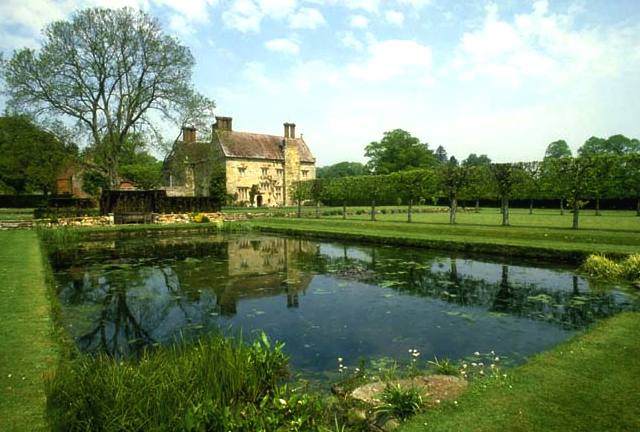
FREEMASONRY
According to the English magazine Masonic Illustrated, Kipling became a Freemason in about 1885, prior to the usual minimum age of 21. He was initiated into Hope and Perseverance Lodge No. 782 in Lahore. He later wrote to The Times, "I was Secretary for some years of the Lodge . . . , which included Brethren of at least four creeds. I was entered [as an Apprentice] by a member from Brahmo Somaj, a Hindu, passed [to the degree of Fellow Craft] by a Mohammedan, and raised [to the degree of Master Mason] by an Englishman. Our Tyler was an Indian Jew." Kipling received not only the three degrees of Craft Masonry, but also the side degrees of Mark Master Mason and Royal Ark Mariner.
Kipling so loved his masonic experience that he memorialised its ideals in his famous poem, "The Mother Lodge", and used the fraternity and its symbols as vital plot devices in his novella, The Man Who Would Be King.
DEATH
Kipling kept writing until the early 1930s, but at a slower pace and with much less success than before. On the night of 12 January 1936, Kipling suffered a haemorrhage in his small intestine. He underwent surgery, but died less than a week later on 18 January 1936 at the age of 70 of a perforated duodenal ulcer. It was two days before the death of King George V. Kipling's
death had in fact previously been incorrectly announced in a magazine, to which he wrote, "I've just read that I am dead. Don't forget to delete me from your list of subscribers."
The pallbearers at the funeral included Kipling’s cousin, the UK Prime Minister Stanley Baldwin, and the marble casket was covered by a Union flag. Kipling was cremated at Golders Green Crematorium, northwest London, and his ashes were buried in Poets' Corner, part of the South Transept of Westminster Abbey, next to the graves of
Charles Dickens and Thomas Hardy.
In 2010 the International Astronomical Union approved that a crater on the planet Mercury would be named after Kipling—one of ten newly discovered impact craters observed by the MESSENGER spacecraft in 2008–9. In 2012, an extinct species of
crocodile, Goniopholis kiplingi, was named in his honour, "in recognition for his enthusiasm for natural sciences". More than 50 unpublished poems by Kipling were released for the first time in March 2013.

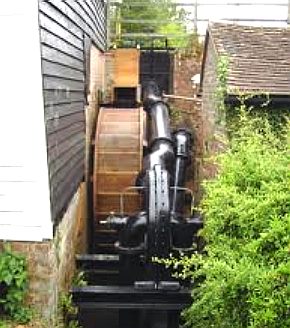
BURWASH - NATIONAL TRUST MUSEUM
After the death of Kipling's wife in 1939, his house, "Bateman's" in Burwash, East
Sussex, South East England, where he had lived from 1902 until 1936, was bequeathed to the National Trust for Places of Historic Interest or Natural Beauty and is now a public museum dedicated to the author. Elsie, his only child who lived to maturity, died childless in 1976, and bequeathed her copyrights to the National Trust.
Novelist and poet Sir Kingsley Amis wrote a poem, 'Kipling at Bateman's', after visiting Kipling's Burwash home (Amis' father had lived in Burwash briefly in the 1960s). Amis and a
BBC television crew went to make a short film in a series of films about writers and their houses.
In 2003, actor Ralph Fiennes read excerpts from Kipling's works from the study in
Bateman's, including, The Jungle Book, Something Of Myself, Kim, and The Just So Stories, and poems, including "If... " and "My Boy Jack", for a CD published by the National Trust.
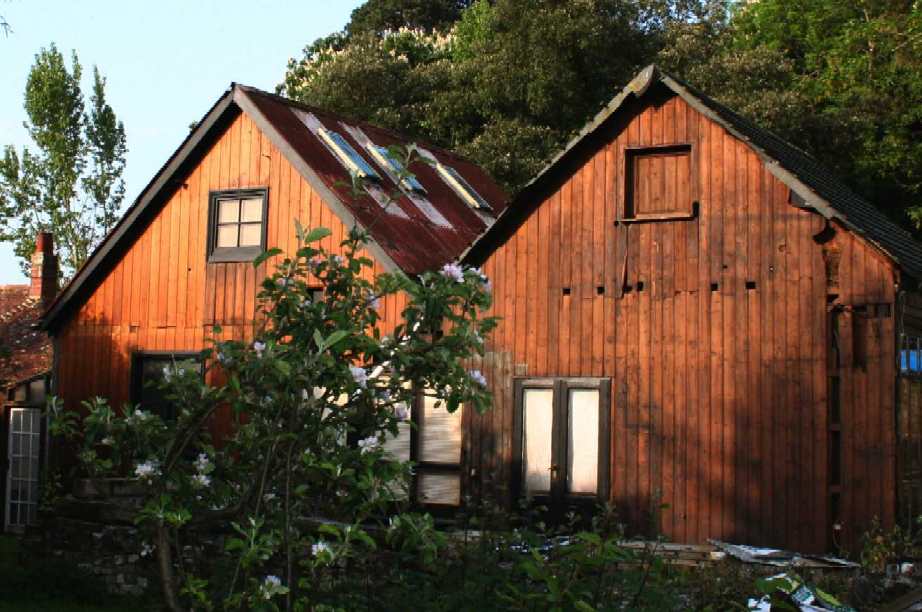
MONUMENT
PROTECTION
Not
so well known is that Rudyard was a keen gadget man, to the extent
that he installed a water turbine to generate electricity to power up
to ten light bulbs. That his house survives, English
Heritage have included this feature on a Monument Protection
Programme, along with Battersea Power Station and another interesting
complex in Herstmonceux, also now a museum.
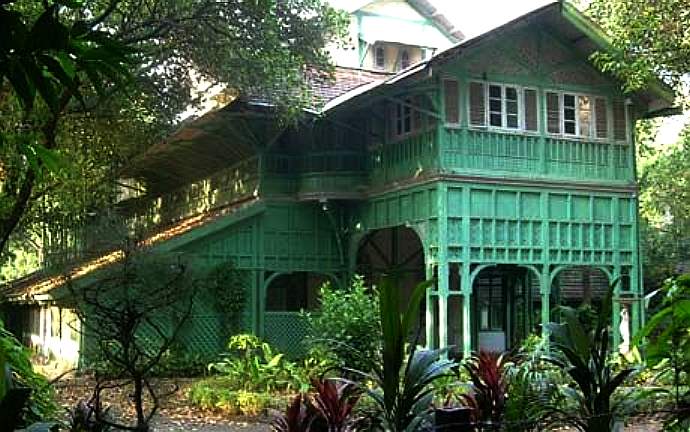
MUMBAI
2010 HISTORIC SITE
The foundation restoring the
Mumbai house has shelved plans to use it to house a Kipling museum, fearing that commemorating the author of The White Man’s Burden and chronicler of the British Raj, will lead to a political
furore. The house, instead, is likely to feature a collection of paintings by local artists.
“If we tried to convert it into a Kipling museum simply because Kipling was born there, that would ruffle quite a few feathers. In the political storm, you may find that the conservation effort would be set aside,” said Mukund Gorashkar, who is in charge of the project for the JSW Foundation, which plans to start the renovation work next month. Kipling was born in 1865 in the Dean’s bungalow in the grounds of the JJ School of
Art in the bustling Victorian heart of the then Bombay. His father, John Lockwood Kipling, was the school’s first dean.
Kipling described the location of the bungalow in his poem To the City of Bombay. His experiences there formed the template for the character he created in his novel Kim – a white boy who is indistinguishable from the Indian children around him.
Mr Gorashkar said the municipal government officials with whom he had dealt since the project began had reprimanded him whenever he referred to the building as the Kipling house, and insisted that it be called the Dean’s house.
Sharad Keskar, Chairman of the Kipling Society, explained: “You have a fairly ignorant officialdom in India, who don’t know much about Kipling apart from that he was an imperialist or part of the Raj. Officially he’s still persona non grata. I think that is changing, but it’s rather a slow change.” The light green
timber building, with its vast, airy rooms, and elegant gothic lattice work, is in urgent need of restoration after suffering severe
water and termite damage while it was left empty between 2000 until 2007.
In 2007, Sangeeta Jindal, the wife of a prominent Indian industrialist, announced that her JSW Foundation would fund the restoration.
At the time, the £300,000 project was to include a Kipling room alongside an exhibition of works from 1880 to the present day by the
college’s students, who include some of India’s most prominent artists.
Subhas Bahulkar, the artist who initially catalogued the school’s archives of past student work, said that although he had found sketches by John Griffiths, who taught drawing in Kipling’s time, he had found no work by Kipling.
Mr Gorashkar said that unless significant work by John Lockwood Kipling was discovered, there would be no grounds for a dedicated Kipling room.
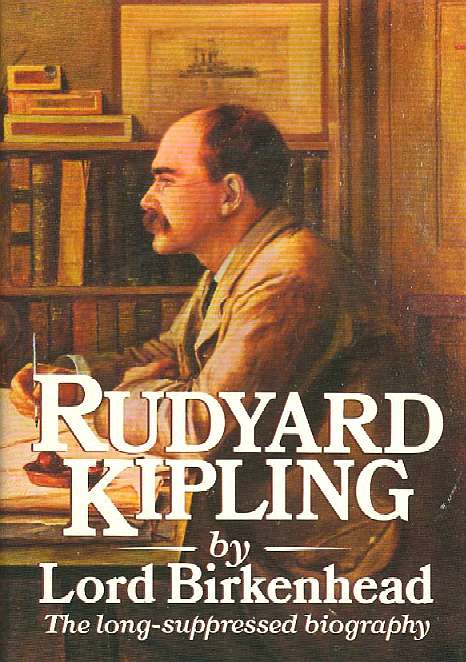
Rudyard
Kipling
LINKS:
Wikipedia http://www.telegraph.co.uk/India-to-turn-Rudyard-Kipling-house-into-museum-but-ignores-author http://candlesbook.com/shopsite_sc/rudyard-kipling-by-lord-birkenhead.html http://en.wikipedia.org/wiki/Rudyard_Kipling
NOVELIST
INDEX
A - Z
GRAPHIC
NOVEL INDEX
A - Z

Scifi
adventure set in the Antarctic
where scientists discover giant
insects
from the age of dinosaurs.
A deadly rivalry develops between expeditionary archaeologists, John
Storm is hired by the UN for his DNA
expertise, unaware of the dangers ahead.
|
The
Jungle Book - Youtube
|
Kim
- Youtube
|
|
